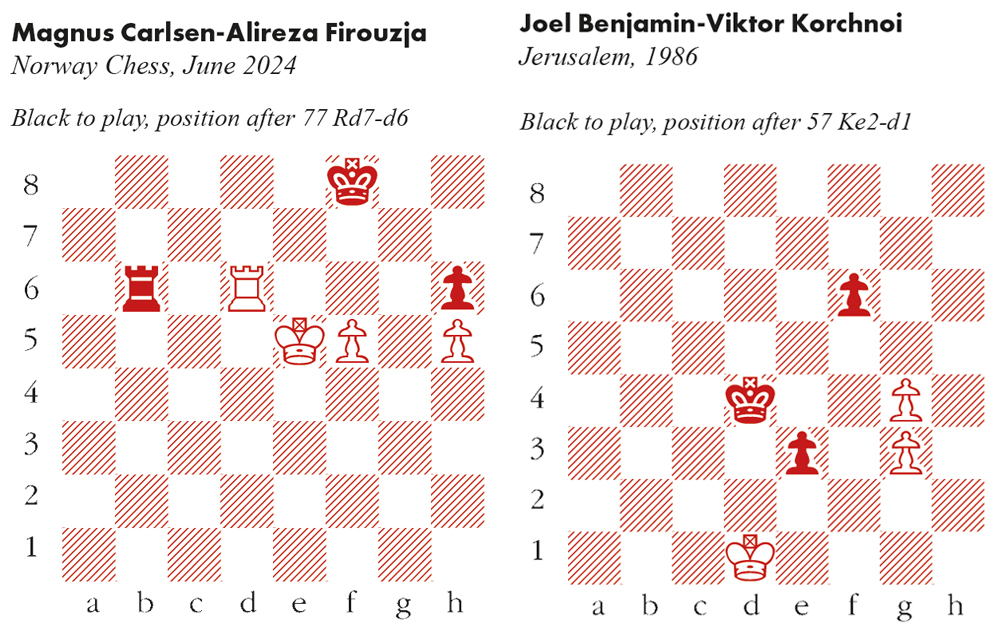Lawyers in a courtroom, it is said, should not ask questions to which they do not already know the answer. Chess players are well advised to adopt a similar attitude to pawn endgames – steer clear unless you can anticipate the outcome with certainty. In endgames with more wood on the board, overlooking a nuance need not be catastrophic. In pawn endgames, nothing is minor, and any oversight can be decisive. Yet their apparent simplicity has the lure of a siren song.
Grandmasters are usually more circumspect, so I was gobsmacked by Alireza Firouzja’s endgame howler in the recent Norway Chess tournament.
Magnus Carlsen-Alireza Firouzja
Norway Chess, June 2024
In the diagram position, Firouzja was faced with a critical decision and he must chart a narrow path to secure the draw. The correct course is to avoid the exchange of rooks with 77…Rb1. This abandons the pawn on h6, but the resulting endgame remains tenable with accurate play, a fact which both players would undoubtedly have known. Perhaps Firouzja was spooked by the possibility of 78 Kf6, threatening mate with Rd6-d8. The drawing path is narrow: 78…Kg8 79 Rd8+ Kh7 80 Rd7+ Kg8 81 Kg6 Rg1+ 82 Kxh6, and after the cool 82…Rg2 83 f6 Rf2 White has no way to win. Instead, presumably in a state of panic, Firouzja sought salvation in the pawn endgame. 77… Rxd6 ?? 78 Kxd6 Kf7 79 Ke5 Ke7 80 f6+ Kf8 81 Kf4 Ke8 82 Ke4 Black resigns At move 81, Carlsen had the move with his king on e5 and pawn on f6, against Firouzja’s king on f8. Firouzja resigned because 82…Kf8 83 Ke5 would wangle the same position with Black to move, which allows Carlsen to break through, e.g. 83…Kf7 2 Kf5 penetrates on g6, or 83…Ke8 2 Ke6 Kf8 3 f7 etc. Carlsen’s dance with Ke5-f4-e4 was a triangulation, designed to pass the move to the opponent. That precise scenario is described in every textbook on pawn endgames, and I find it inconceivable that Firouzja would not have studied it.
In his absorbing book Liquidation on the Chessboard: Mastering the Transition into the Pawn Endgame (3rd ed., New In Chess 2020) the American player Joel Benjamin recounts a lesson he learned as a newly fledged grandmaster when he encountered the endgame maestro Viktor Korchnoi.
Joel Benjamin-Viktor Korchnoi
Jerusalem, 1986
The game was adjourned in the position below, with Benjamin initially optimistic in view of 57…Kd3 58 Ke1 e2 59 g5 fxg5 60 g4 Ke4 61 Kxe2 with a book draw. ‘I know something about triangles,’ said Korchnoi, enigmatically. The winning line he had foreseen was 59…Kd5 60 Ke1 Ke5 61 Kd1 Kd4 (a perfect analogue of Carlsen’s motif) 62 Ke1 Kd3 63 Kd1 e2+ 64 Ke1 Ke3 65 g5 fxg5 66 g4 Kf3 etc. When the penny dropped, Benjamin resigned, apologising for his ignorance. Korchnoi replied: ‘It is the ABCs of chess!’






Comments